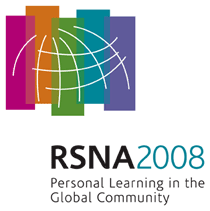
Abstract Archives of the RSNA, 2008
VS41-06
Test-Retest and Inter-Reader Precision of T2 Relaxation Times in Healthy and Osteoarthritic Human Tibial Cartilage
Scientific Papers
Presented on December 3, 2008
Presented as part of VS41: Musculoskeletal Series: Cartilage Imaging
Annie Horng MD, Presenter: Nothing to Disclose
José Raya MSc, Abstract Co-Author: Nothing to Disclose
Kathrin Nixdorf, Abstract Co-Author: Nothing to Disclose
Thomas Mendlik MSc, Abstract Co-Author: Nothing to Disclose
Weber Juergen, Abstract Co-Author: Nothing to Disclose
Maximilian F. Reiser MD, Abstract Co-Author: Nothing to Disclose
Karin Anna Herrmann MD, Abstract Co-Author: Nothing to Disclose
Christian Glaser MD, Abstract Co-Author: Nothing to Disclose
et al, Abstract Co-Author: Nothing to Disclose
T2 relaxation time has high potential for the diagnostic work up of osteoarthritis (OA). Systematic data on T2 precision errors are available only for healthy patellar cartilage. Therefore, the purpose of this study was to assess tibial cartilage T2 precision errors in healthy volunteers and OA patients.
The dominant knee of 28 healthy volunteers of 2 age groups (n=14, mean 27y; n=14, mean 50y) and 16 OA patients were analysed by two readers in 3 consecutive measurements (knee repositioning) using a coronal multiecho sequence (TR 3000ms/TE 13,2ms/8 echoes/resolution 0,6²x3mm³) at 1,5T.
T2 maps were calculated pixel-wise (exponential fit). Global (average T2 of complete cartilage layer) and regional (superficial/deep layer + 4 sections perpendicular to the 2 layers resulting in 8 sectors per MRI slice and a total of 104 (medial) and 80 (lateral) sectors) test-retest and inter-reader precision errors were calculated as root mean square average (RMSA) of individual standard deviations [SD, ms] and coefficients of variation [COV, %]. Interindividual variability was determined as RMSA of interindividual SD and COV.
Healthy global and regional test-retest precision error was 7.9/14.5% (2.5/4.5ms) for medial and 6.9/13.8% (2.2/4.2ms) for lateral tibiae; in OA 7.2/12.1% (2.2/3.7ms) for medial and 6.3/11.2% (2/3.5ms) for lateral tibiae. There was no significant difference between medial and lateral tibiae nor between healthy subjects and patients. Healthy interindividual variability was 8,8% (2,8ms). Inter-reader precision error was 6.3% globally and 12.6% regionally.
Global precision errors of tibial cartilage were slightly higher compared to reported data of patellar cartilage, possibly related to lower thickness and increased partial volume effects. Regional precision errors were comparable to those of patellar cartilage. T2 precision errors were small compared to reported change in OA cartilage suggesting good discriminatory power of the technique and may contribute to determine sensitivity to change (smallest detectable difference).
The estimated global and regional T2 precision errors in healthy and diseased tibial cartilage may provide a base for sample size calculations to design longitudinal and cross-sectional trials in OA.
Horng, A,
Raya, J,
Nixdorf, K,
Mendlik, T,
Juergen, W,
Reiser, M,
Herrmann, K,
Glaser, C,
et al, ,
Test-Retest and Inter-Reader Precision of T2 Relaxation Times in Healthy and Osteoarthritic Human Tibial Cartilage. Radiological Society of North America 2008 Scientific Assembly and Annual Meeting, February 18 - February 20, 2008 ,Chicago IL.
http://archive.rsna.org/2008/6018510.html

